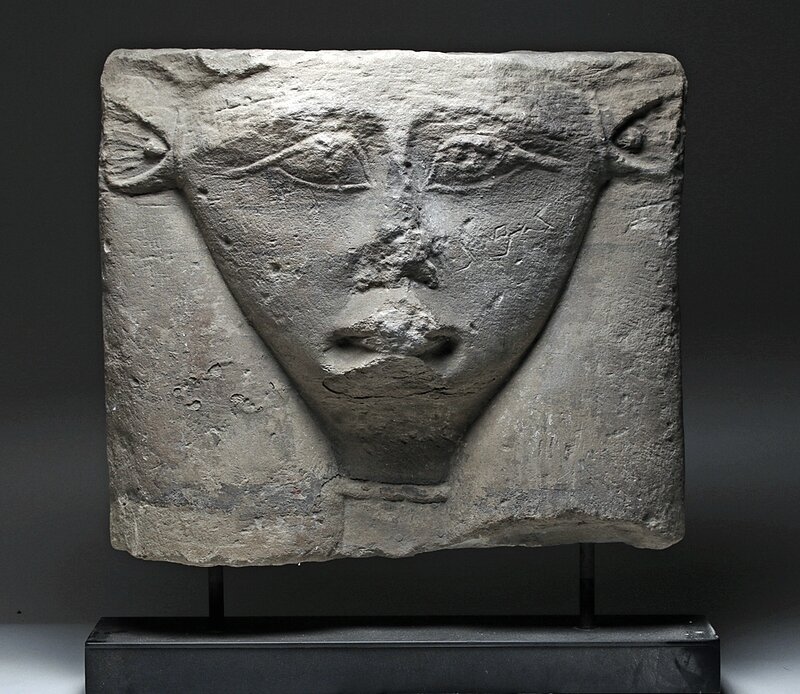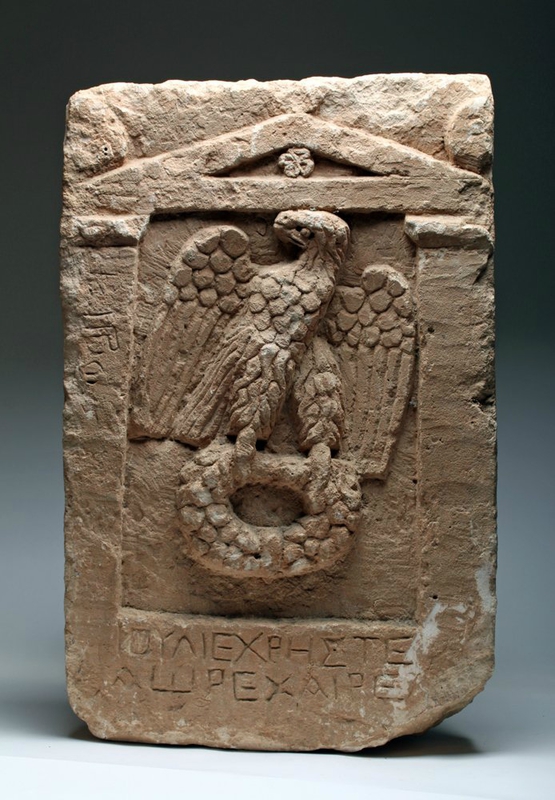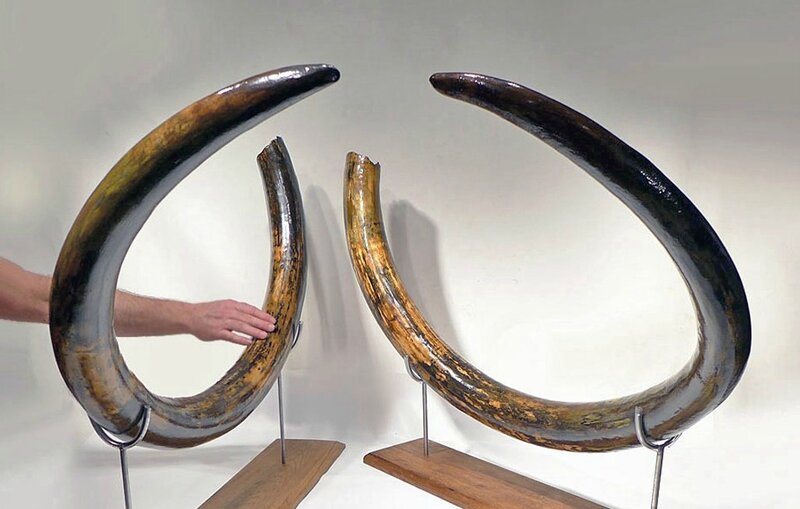Artemis Gallery to auction museum-quality ancient, Asian and ethnographic art & antiquities, Oct. 22
Important Egyptian limestone relief of the goddess Hathor, New Kingdom, ca. 1570 to 1069 BCE. Est. $30,000-$40,000.
BOULDER, Colo. – Provenance is always desirable, no matter what the collecting category may be, but when the object of pursuit is a premier cultural antiquity, prior ownership and the assurance that an item is legal to purchase escalate from “important” to “absolutely essential.” Artemis Gallery’s owners, Bob and Teresa Dodge, established their company on a foundation of knowledge and integrity, issuing an unconditional guarantee that every piece they offer is authentic and unquestionably legal for bidders to purchase. And it is that steadfast business mantra that continues to bring Artemis Gallery the caliber of consignments such as those seen in their Oct. 22 online auction of Exceptional Ancient, Asian and Ethnographic Art. Absentee and Internet live bidding will be available through LiveAuctioneers.
“We have a very selective and uncompromising clientele,” said Bob Dodge, co-owner of Artemis Gallery. “Many are connoisseurs who are prepared to pay a premium to own the very best. They already know that if an object is in our auction, it’s authentic, but they also want an ironclad assurance that there won’t be a problem later on with regard to cultural patrimony. We do all of the background work for them so they can buy with confidence. On the other hand, sellers know that we have a following with institutions and high-end collectors, so they entrust us with their very best things.”
The October 22nd online auction is a first-class event brimming with museum-worthy examples of classical antiquities and ethnographic art from scores of ancient cultures. An overview of highlights reveals a Greek Attic amphora previously deaccessioned by the Museum of Fine Arts, Boston; a large and impressive Ancient Roman mosaic of a bacchante, and a circa-1750 Indian bronze figure of Parvati, purportedly a gift from Mahatma Gandhi to a prior owner, in 1946. There are many intriguing rarities of the Pre-Columbian world, plus coveted Roman glass, and even a matched pair of complete Pleistocene woolly mammoth tusks.
Egyptian
Endlessly fascinating, the Ancient Egyptians entombed their most highly prized relics, and for thousands of years, their treasures have mystified scholars. Several auction highlights shine a light on Egypt’s fascinating past. One of the finest pieces in the sale, Lot 3, shown at top, is a 23 by 21-inch limestone relief of the goddess Hathor. Dating to the 18th to 20th Dynasties (circa 1570-1069 BCE) and formerly in the prestigious Simonian collection (Switzerland), it is expected to sell for $30,000-$40,000.
Lot 7 is a superb Egyptian bronze cat – the goddess Bastet in her animal form, seated in a sophisticated pose. Exhibiting a beautiful green, red and brown patina, the figure was originally part of a small bronze sarcophagus lid and dates to the Late Period, circa 661-332 BCE. Its estimate is $7,000-$9,000. Immediately following as catalog Lot 7A is an Egyptian wood ushabti box, its lid decorated with the detailed depiction of an embalming scene. Estimate: $8,000-$9,000.
Greek
Two antiquities formerly in the collections of legendary London dealer Charles Ede and the Museum of Fine Arts in Boston lead the Greek section. Lot 10, shown below, is a spectacular Greek Attic amphora adorned with a black-figure motif of a satyr and a maened duo engaged in a lively dance. Dating to circa 510 BCE, the 12½-inch amphora is similar to an example in the Getty Museum. It is estimated at $50,000-$70,000. Sharing the same provenance is Lot 12, a 12½-inch-tall Greek Attic lekythos with circumferential artwork attributed to the Reed Painter. Bidding could reach the $25,000-$35,000 range.
Greek Attic black-figure neck amphora, Athens, 510 BCE. Ex-Museum of Fine Arts, Boston. Est. $50,000-$70,000.
Roman
Growing rapidly in popularity with collectors, the subcategory of Roman glass is represented by a superior selection from art dealer to the rich and famous, Stuart Denenberg Fine Arts of Los Angeles. Lot 18, an imposing trefoil oinochoe, circa 3rd to 4th century CE, is one of the largest ancient glass vessels ever consigned to Artemis Gallery. Standing 10 1/8 inches tall, it is cataloged with a $6,000-$8,000 estimate. Lot 22, a tall, circa 100 CE blown-glass jug with lustrous natural finish is estimated at $3,000-$4,500, as is Lot 24, a handsome pyriform handled jug.
In the Roman art section, there are numerous highlights. Lot 31F, a beautifully preserved 9th-century stone stele of the goddess Devi, ex Christie’s Amsterdam, is estimated at $20,000-$30,000. A circa 300 CE Roman legionary stele with a bas relief eagle and a Greek inscription that translates “Julius the Virtuous Be Well” is entered as Lot 26, shown below, with a presale estimate of $20,000-$30,000.
Roman legionary stele, translated Greek inscription, ca. 300 CE. Est. $20,000-$30,000.
A masterpiece among Roman artworks, Lot 26A (shown below) is a superb 2nd-3rd century CE Roman mosaic of a bacchante from the Four Seasons series, $85,000-$100,000. “This artwork most likely would have been displayed in the dining room of a Roman villa, as opposed to a public place,” Bob Dodge noted. “It would have been very highly regarded in its day, just as it is now.”
Large and exceptional Ancient Roman mosaic, autumn season, Near East, ca. 2nd to 3rd century CE. Est. $85,000-$100,000.
Asian
“Most of the Asian pieces in the auction came from Patrick and Nancy Kipper, who traveled throughout Asia – India, Thailand, Burma, Japan – and made many savvy purchases over a 25-year period,” said Bob Dodge. “The Kippers were discriminating buyers who settled for nothing less than the best. Literally every piece in their collection is an impeccable choice, both artistically and from the standpoint of historical significance.”
Lot 31E, an 18th-century Indian solid-cast bronze figure of Uma (Parvati), consort of Shiva, was purportedly gifted to its previous owner by Mahatma Gandhi, in 1946. Standing 19½ inches tall, the statue of the elegant deity is estimated at $13,000-$19,000.
Previously auctioned at Christie’s Amsterdam, Lot 31F is a 9th-century pala stone stele with a relief image of the serene goddess Devi seated on a cushion, the base carved with her lion and an adorant at the front, and her four hands holding the specific attributes. A $20,000-$30,000 estimate has been placed on this work.
Several lots come with provenance from past Sotheby’s sales, among them: Lot 32A (shown below), a Khmer Buddha Avalokiteshvara Prajnaparamita, est. $7,000-$8,000; Lot 39B, a 19th-century Nepalese gilt bronze Yab-Yum, est. $2,000-$3,000; and Lot 39D, a Nepalese bronze thousand-arm Bodhisattva, est. $1,750-$2,625.
Khmer Bronze Buddha, Avalokiteshvara and Prajnaparamita, Cambodia, Angkor period, ca. late 1100 CE. Ex-Sotheby’s. Est. $7,000-$8,000.
Pre-Columbian
The October 22nd sale contains arguably the best variety of high-end Pre-Columbian art Artemis Gallery has ever brought together in one event. Two circa 559-850 CE Mayan polychrome cylinders from the Ulua Valley, Honduras, display fantastical hand-painted imagery. Lot 55 is decorated with iconography of a procession honoring an ostentatiously dressed royal personage on a throne. His subject, who bows to the lord, wears a jaguar head, representing an animal of symbolic importance to the Mayan culture since before the flourishing of Chichen Itza. Lot 56, shown below, is crafted and decorated in classic Mayan style with three fine depictions of a standing black jaguar. Its estimate is $4,000-$8,000.
Mayan polychrome cylinder with black jaguar (ex-balanque), Ulua Valley, Honduras, ca. 550 to 850 CE. Est. $4,000-$8,000.
With provenance from an old Japanese collection, Lot 58A, below, is a carved green stone Veracruz ritual ball game effigy yoke. There are varying theories as to the purpose of such implements, which have been found at all of the major Pre-Columbian sites where Mayan spectator games were played.
Superb Veracruz carved green stone effigy yoke, Mexico, Late Classic period, ca. 600 to 900 CE. Est. $30,000-$40,000.
“It is possible that they were worn as belts by the athletes and used as a part of the game, perhaps as a surface upon which the athletes bounced the ball,” said Dodge. “Or it’s possible they were purely ceremonial replicas of wooden yokes worn by the athletes. Burial sites near ball courts have revealed bodies wearing stone yokes like the one in our auction.” An exceptional example with deeply incised iconography, the yoke is expected to attract bids in the vicinity of $30,000-$40,000.
Natural History, African and Mexican Art
The sale is rounded out by medieval weaponry, African and Mexican art, and a highly select collection of 12 fossils, including Lot 91, shown below, an extremely rare matched pair of investment-grade Pleistocene woolly mammoth tusks, estimated at $80,000-$100,000. Lot 92 is a complete scapula from a woolly mammoth. Estimate: $10,000-$12,000.
Rare matched pair European woolly mammoth tusks, Holland, Pleistocene, 150,000 to 200,000 years ago. Est. $80,000 to $100,000.
“All of the fossils in this collection are rare and special,” said Dodge. “They are in ‘as found’ condition and completely original. It’s very unusual to find fossils of their rarity in such an amazing state of natural preservation.” In addition to the woolly mammoth tusks, there are fossils from a dyrosaurus skull, plagiolophus (three-toed horse), the claw of a paramylodon (giant sloth), and camptosaurus vertebrae. Several lots are stunning representations of fossilized marine life. Lot 81, a prehistoric slab with numerous starfish fossils, is estimated at $20,000-$25,000; while Lot 82 is a virtual wall of 28 Middle Jurrasic fossilized ammonites – so striking it could be mistaken for an artwork. A selling price is expected in the vicinity of $20,000-$25,000.
Among the African rarities is Lot 71C, shown below, a sacred African Lobi tribal human shrine vessel estimated at $7,500-$10,000.
Sacred African Lobi tribal human shrine vessel, intact, late 19th-early 20th centuries CE. Est. $7,500 to $10,000.
Bidders are invited to participate in Artemis Gallery’s Thursday, Oct. 22, 2015 auction either absentee or live online through LiveAuctioneers. The sale will begin at 11 a.m. Eastern Time. For additional information about any item in the auction, call Teresa Dodge at 720-890-7700 or emailteresa@artemisgallery.com.

/https%3A%2F%2Fprofilepics.canalblog.com%2Fprofilepics%2F1%2F0%2F100183.jpg)
/https%3A%2F%2Fstorage.canalblog.com%2F03%2F02%2F119589%2F96711876_o.jpg)
/https%3A%2F%2Fstorage.canalblog.com%2F11%2F31%2F119589%2F94773502_o.jpg)
/https%3A%2F%2Fstorage.canalblog.com%2F20%2F83%2F119589%2F94772815_o.jpg)
/https%3A%2F%2Fstorage.canalblog.com%2F26%2F72%2F119589%2F75604929_o.jpg)
/https%3A%2F%2Fstorage.canalblog.com%2F59%2F60%2F119589%2F26458628_o.jpg)











/image%2F1371349%2F20240418%2Fob_ac5c4c_telechargement.jpg)
/image%2F1371349%2F20240418%2Fob_709b64_304-1.jpg)
/image%2F1371349%2F20240418%2Fob_22f67e_303-1.jpg)
/image%2F1371349%2F20240417%2Fob_9708e8_telechargement.jpg)